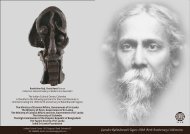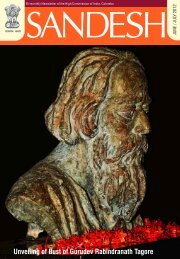Remembering Rabindranath Tagore Volume - High Commission of ...
Remembering Rabindranath Tagore Volume - High Commission of ...
Remembering Rabindranath Tagore Volume - High Commission of ...
You also want an ePaper? Increase the reach of your titles
YUMPU automatically turns print PDFs into web optimized ePapers that Google loves.
12<br />
<strong>Remembering</strong> <strong>Rabindranath</strong> <strong>Tagore</strong><br />
Ideas <strong>of</strong> motherhood also come in for critical scrutiny, for the childless Binodini’s longing<br />
for maternity makes it impossible to sustain the contrast between “good mother” and “bad<br />
mother”. When Bihari rejects Binodini’s advances, she finds solace in her affection for the<br />
eight year old Basant who is Bihari’s pupil. Here, Binodini’s dormant maternal instincts are<br />
aroused, and they are represented in the text as a positive, redemptive force. In contrast,<br />
Rajalakshmi emerges as a possessive mother who regards her son as a substitute for her<br />
husband, and resents his relationship with Asha. Although he is twenty-two, Mahendra<br />
remains under his mother’s thumb: “Like a baby kangaroo that lives in its mother’s pouch<br />
even after birth, he had grown accustomed to the shelter <strong>of</strong> his mother’s protective care”<br />
(CB 2).Rajalakshmi represents the negative side <strong>of</strong> mother-love, which contradicts the<br />
institutionalization <strong>of</strong> motherhood in nationalist discourse in nineteenth century Bengal.<br />
Chokher Bali charts the decline <strong>of</strong> the joint family in Bengal, a phenomenon <strong>of</strong> which <strong>Tagore</strong><br />
had become aware by 1880.The novel depicts a small family with one male head.Asha, the<br />
daughter-in-law, is expected to submit to the authority <strong>of</strong> her mother-in-law Rajalakshmi.<br />
In this compact domestic arrangement, Annapurna and Binodini occupy the position <strong>of</strong><br />
dependents who are short-term residents.In the novel, Mahendra marries Asha for love;<br />
he also tries to educate her. This break from the customary arranged marriage indicates the<br />
shift towards companionate marriage, an idea that was gaining currency in Bengal as a result<br />
<strong>of</strong> exposure to Western culture. At the same time, the text demonstrates the difficulties<br />
inherent in such a paradigm shift, for the ideal <strong>of</strong> prem or romantic love causes conflict<br />
with the traditional environment <strong>of</strong> the rest <strong>of</strong> the household (Panja). Chokher Bali thus<br />
represents a society in transition, and the ways in which changes in the family structure<br />
affected the lives <strong>of</strong> women.<br />
Asha’s character is also a feature <strong>of</strong> the text’s modernity. She does not conform to<br />
Bankimchandra’s stereotypes <strong>of</strong> prachina, the traditional woman skilled in domestic affairs,<br />
and nabina, the westernized “modern” woman who seeks social sophistication while<br />
neglecting household responsibilities. Asha’s ignorance and naivete, which Mahendra at<br />
first finds so charming, begin to annoy him when he discovers Binodini’s domestic skills.<br />
Asha, however, does not accept Mahendra’s betrayal when he becomes infatuated with<br />
Binodini. “She was unable to follow her mashi’s advice, the dictates <strong>of</strong> the puranas, the<br />
discipline enjoined upon her by the scriptures; she could no longer worship this husband<br />
who had fallen from the pedestal <strong>of</strong> conjugal love. Today, she deconsecrated the lord <strong>of</strong> her<br />
heart, immersing him in the sea <strong>of</strong> shame that was Binodini” (CB 310-11). Asha’srejection<br />
<strong>of</strong> the passive tolerance enjoined upon the devoted Hindu wife, her refusal to abide by the<br />
decrees <strong>of</strong> tradition and the scriptures, is a significant marker <strong>of</strong> the modernity <strong>of</strong> <strong>Tagore</strong>’s<br />
novel (Bhattacharya and Bhattacharya 37).Although she forgives Mahendra in the end, she<br />
does so with a newfound affirmation <strong>of</strong> choice and self-assurance.<br />
Bihari, too, is a complex figure. Although he is educated, he does not take up a regular<br />
pr<strong>of</strong>ession. Instead, he takes up social service, choosing to work for the benefit <strong>of</strong> those

















